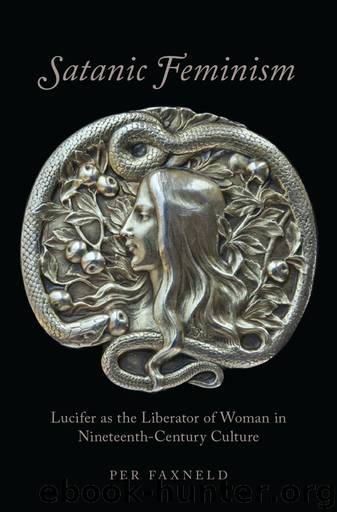Satanic Feminism: Lucifer as the Liberator of Woman in Nineteenth-Century Culture by Per Faxneld

Author:Per Faxneld
Language: eng
Format: epub
Publisher: Oxford University Press
Published: 2017-08-23T16:00:00+00:00
‘THE TRUE FATHER OF THE INFERNAL CHURCH’: THE ART OF FéLICIEN ROPS
Having delineated the Decadent genre and detailed the general role of Satanism and demonic women in such texts, we will now undertake the chapter’s first extended case study. In the second half of the nineteenth century, the visual representation of Satanism was a market niche cornered almost exclusively by a certain Félicien Rops (1833–1898). He grew up in the provincial town of Namur, not far from Brussels, and lost his father at age twelve. The boy’s devoutly Catholic mother was thus left in sole charge of his education. Even many years later, he was therefore able to recite the gospels in Latin from memory. As a teenager, Rops read both the Romantic literature that was fashionable at the time and more unexpected and obscure works like the Malleus Maleficarum.157 In Rops’s œuvre, we can hence observe a coupling of his intimate knowledge of the Bible and the witch lore of the Malleus with the spirit of rebellion and love of shock effects typical of Romanticism. There was never, we should note, a formalized movement of any kind in pictorial art using the self-designation ‘Decadent’, but it is clear that Rops’s imagery is rich in the kind of motifs popular with literary Decadents (if not, perhaps, fully similar in attitude to them). Mario Praz accordingly assures us that he ‘is the artist most representative of the Decadent Movement’.158 Indeed, Rops developed a friendship with the most influential precursor of Decadence, Charles Baudelaire, and engraved the frontispiece to a small volume of his banned poems. Rops’s own work came to be strongly influenced by the poet’s favourite subjects and typical metaphors.159 The appreciation was mutual, and Baudelaire composed a sonnet praising the artist.160 Other men of letters that Rops knew in private included Théophile Gautier and Prosper Mérimée. Further on, authors like Octave Mirbeau, Octave Uzanne, Emile Verhaeren, Joséphin Péladan, and Huysmans wrote laudatory essays on his work.161 The obscure poet Pierre Caume even produced an entire collection of poems about his work, Les Ropsiaques (1898).162
Rops’s star reached its zenith in the mid-1880s. At this point, the middle-aged artist became the darling of the literary avant-garde (with his engravings gracing books by Mallarmé, Verlaine, and similar figures) and also achieved a limited amount of fame with a wider audience. Most of his work was in the field of illustration, rather than produced for the salons of high art, and he was now among the best-paid illustrators in the francophone world. In 1888, Rops was even awarded the cross of the Légion d’Honneur, though this was, typically enough, followed three days later by the authorities confiscating three books he had illustrated, as the pictures within were perceived as a threat to public morals. Earlier, Rops had been seen as something of a marginal eccentric. With the broad reaction against the materialism underpinning realist and impressionist painting, however, artists like Rops and Moreau emerged as appealing alternatives to the dominant anti-idealist focus on everyday matters and things.
Download
This site does not store any files on its server. We only index and link to content provided by other sites. Please contact the content providers to delete copyright contents if any and email us, we'll remove relevant links or contents immediately.
| Baha'i | Cults |
| Demonology & Satanism | Eckankar |
| Egyptian Book of the Dead | Freemasonry |
| Messianic Judaism | Mysticism |
| Scientology | Theism |
| Tribal & Ethnic | Unitarian Universalism |
The Four Agreements by Don Miguel Ruiz(6630)
Breaking Free by Rachel Jeffs(4175)
The Hatha Yoga Pradipika (Translated) by Svatmarama(3228)
120 Days of Sodom by Marquis de Sade(3178)
Member of the Family by Dianne Lake(2302)
The Tao of Physics by Fritjof Capra(2229)
The Psychedelic Gospels: The Secret History of Hallucinogens in Christianity by Jerry B. Brown(2121)
The Road to Jonestown by Jeff Guinn(2019)
Going Clear: Scientology, Hollywood, and the Prison of Belief by Lawrence Wright(1937)
Going Clear by Lawrence Wright(1922)
Uriel's Machine by Christopher Knight(1862)
The Grand Grimoire: The Red Dragon by Author Unknown(1760)
The Gnostic Gospel of St. Thomas by Tau Malachi(1736)
Key to the Sacred Pattern: The Untold Story of Rennes-le-Chateau by Henry Lincoln(1594)
The Malloreon: Book 02 - King of the Murgos by David Eddings(1558)
Waco by David Thibodeau & Leon Whiteson & Aviva Layton(1530)
The New World Order Book by Nick Redfern(1525)
Animal Speak by Ted Andrews(1514)
The Secret of the Temple by John Michael Greer(1463)
